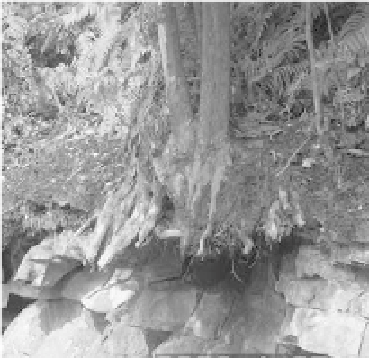Environmental Engineering Reference
In-Depth Information
(a) (b)
Fig. 2.9
(a) Tile structure on the slope in the Xiaojiang River basin in southern China; (b) Vegetation cover protecting
the soil from various erosion (See color figure at the end of this topic)
2.1.3
Grain Erosion and Control Strategy
Grain erosion is a unique type of erosion that occurred intensively in the dry valleys in Yunan, especially
in Sichuan after the Wenchuan Earthquake, which occurred at the Longmenshan fault on May 12, 2008,
in China. Grain erosion is defined as the phenomenon of breaking down of bare rocks under the action of
sun exposure and temperature changes, detachment of grains by wind, flow of grains down the slope
under the action of gravity, and accumulation of eroded material at the toe of the mountain forming a
deposit fan. The grains, 0.1-200 mm in diameter, jump and hit against the mountain slope surface and
cause detachment of slope debris or rock surface, which results in further erosion. Bare rocks were cause
by avalanches, landslides, and human activities. Grain erosion of bare rocks is much (100-1000 times)
more intensive than shattering erosion. Rock fall, bank failure, avalanche and landslide resulted in bare
rocks in mountainous areas, especially the mountainous areas experiencing riverbed incision. Human
activities, such as highway construction and mining, also cause bare rocks. Mass movements triggered by
the Wenchuan Earthquake have left a huge area of bare rocks (Wang et al., 2009b). Erosion of rocks has
been occurring in the form of grain detachment and movement. The erosion is extremely intense. A
surface layer of 3-50 cm of the bare rocks has been eroded one year after the earthquake.
The grain particles are removed from the parent rocks by wind or tremors, and they roll, slide, or saltate
down and scour the slope like a water flow
ˈ
then accumulate at the toe of the mountain and form a deposit
fan. It is difficult to classify such a type of erosion into weathering, shattering erosion, slope erosion,
wind erosion, or gravity erosion. Different from other erosion types the solid particles have rather uniform
size and the detachment and movement are generally in single grain or multiple grains. Thus, such a type
of erosion is named
grain erosion
and the flow of grains on slopes is named
grain flow
.
Grain erosion also occurred before the Wenchuan Earthquake in dry valleys with poor vegetation. Dry
valleys have two unique features, which may be used as diagnostic characteristics:
ķ
deeply incised valley
on a plateau; and
ĸ
significantly higher temperatures and evaporation rates and lower precipitation
than the surrounding area on the plateau. The Jinsha River valley (upper Yangtze River), the upper Minjiang
River valley, and the Xiaojiang River valley are dry valleys. The Xiaojiang River is a small tributary of
the Jinsha River in Yunnan Province. Rockfalls, avalanches, slope slumps, small scale landslides, or
human activities resulted in bare rocks on slopes in the dry valley. Grain erosion has been occurring on
the bare rocks for more than ten years. The problem was not given paid much attention before the
Wenchuan Earthquake because the area of grain erosion was small.



Search WWH ::

Custom Search